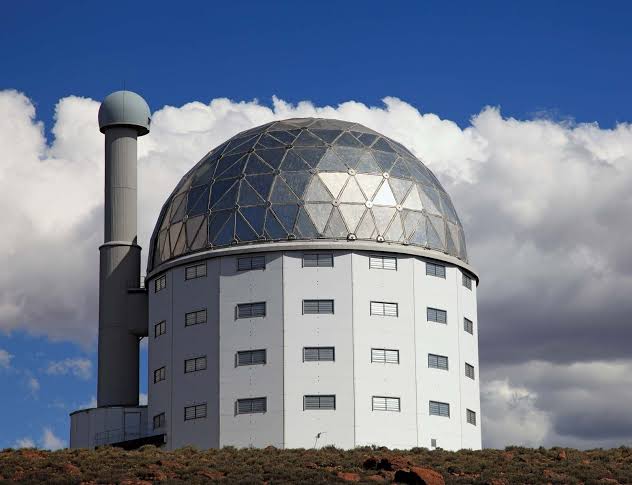
Humanity’s quest to understand the universe has prompted the creation of ever-larger and more powerful telescopes. As we go through 2025, the landscape of huge astronomical observatories is in a state of exciting development, with new behemoths preparing to come online in the coming years. While the meaning of “largest” might relate to several elements such mirror diameter or light-gathering capability, this article focuses on the primary mirror size, the key determinant of a telescope’s power to collect light and resolve dim objects.
List Of Top 10 Largest Telescopes In The World 2025
1. Gemini South

The powerful International Gemini Observatory is comprised of two telescopes: the Gemini South telescope, which is situated on Cerro Pachón, where it is situated high in the Andes of Chile. Together with its counterpart, Gemini North, which is located in Hawaii, it offers astronomers from the countries that are partners with it nearly comprehensive coverage of both the Northern and Southern Hemispheres throughout their observations. Because of its advantageous location, the Gemini Observatory is able to conduct research on astronomical phenomena regardless of where they are located in the sky. This makes it an indispensable resource for the field of astronomy analysis.
2. Giant Magellan Telescope

The Giant Magellan Telescope (GMT) is set to become one of the most powerful astronomical observatories that have ever been constructed. It is located at the Las Campanas Observatory, which is located high in the pure, dry air of the Atacama Desert in Chile. This ambitious ground-based telescope that is exceedingly huge is now in the process of being constructed. When it begins operations in the early 2030s, it is expected to revolutionize our understanding of the universe.
3. Magdalena Ridge Observatory Interferometer

Located in the Magdalena Mountains of New Mexico, the Magdalena Ridge Observatory Interferometer (MROI) is an ambitious project that aims to provide astronomers with a vision of the universe that is unlike anything they have ever seen before. In contrast to conventional telescopes with a single mirror, the MROI makes use of the power of interferometry. It does this by combining the light from a number of smaller telescopes in order to attain the angular resolution of a much larger, hypothetical telescope.
4. Subaru Telescope

The Subaru Telescope, which is located in Hawaii and is perched atop the gorgeous Maunakea volcano, is a prominent example of worldwide cooperation and cutting-edge astronomical engineering. Since it initially shed light in January 1999, this 8.2-meter optical-infrared telescope, which is operated by the National Astronomical Observatory of Japan (NAOJ), has been an essential tool in the process of elucidating the secrets of the universe. This enormous eye, which has been given its name after the Pleiades star cluster (which is referred to as Subaru in Japanese), has repeatedly made ground-breaking findings that have pushed the limits of our understanding of the larger cosmos.
5. Thirty Meter Telescope

An ambitious worldwide effort with the goal of constructing one of the largest and most powerful ground-based astronomical observatories in the world is known as the Thirty Meter Telescope (TMT). Featuring a primary mirror that is thirty meters (98 feet) in diameter, the TMT has the potential to transform our understanding of the universe by providing a level of sensitivity and resolution that has never been seen before. This telescope of the next generation is intended to investigate the universe in wavelengths ranging from the near-ultraviolet to the mid-infrared, with the goal of discovering mysteries ranging from the origins of galaxies to the possibility of life existing beyond Earth.
6. Gran Telescopio Canarias

As one of the largest and most technologically advanced optical and infrared telescopes in the world, the Gran Telescopio Canarias (GTC) is located on the island of La Palma in the Canary Islands, Spain. It is perched atop the Roque de los Muchachos Observatory. Since its inception in 2009, the GTC has been an essential instrument for astronomical study. Its magnificent segmented primary mirror, which measures 10.4 meters in length, has provided a powerful view into the depths of the universe.
7. Large Binocular Telescope

The Large Binocular Telescope (LBT) is an extraordinary and potent piece of astronomy equipment that is nestled atop Mount Graham in Arizona, in the United States of America. The LBT is not just one telescope, as its name suggests; rather, it is comprised of two primary mirrors that are identical and measure 8.4 meters (27.6 feet) in length and are set side-by-side on a single mount. Using this cutting-edge design, astronomers are able to perform interferometry and have access to outstanding light-gathering power, which in turn gives them with an unrivaled perspective on the universe.
8. Southern African Large Telescope

South Africa’s Southern African Large Telescope (SALT) is a shining example of scientific aspiration and international cooperation. It is situated on a remote plateau in the Karoo semi-desert, which is located in South Africa. SALT has been the largest single optical telescope in the Southern Hemisphere ever since it was initially lit up in 2005. It has provided astronomers with a powerful eye that provides them with the opportunity to explore the wonders of the cosmos that are frequently out of reach for their colleagues in the northern hemisphere.
9. Hobby Eberly Telescope

The Hobby-Eberly Telescope (HET) is a large-aperture telescope that is located at the McDonald Observatory in West Texas. It is a tribute to inventive engineering and a cost-effective approach to the construction of large-aperture telescopes. With its primary mirror measuring 10 meters in diameter, the HET has emerged as a prominent facility for spectroscopic research all over the world. It investigates the light coming from faraway galaxies and stars in order to discover the fundamental characteristics of these objects.
10. W. M. Keck Observatory Headquarters

Despite the fact that the twin domes of the W. M. Keck Observatory are majestically perched above the peak of Maunakea in Hawaii, the operational and administrative heart of this world-leading astronomical institution beats at its Headquarters, which is located in Waimea, also known as Kamuela, on the Big Island of Hawaii. This facility, which has won multiple awards and is located in the foothills of the Kohala Mountains, plays an important role in mediating communication between the powerful telescopes that are located on the mountain and the international community of astronomers who make use of them. A.




